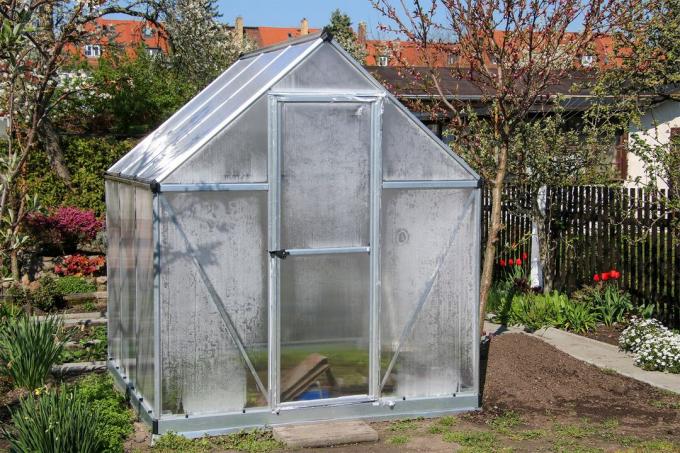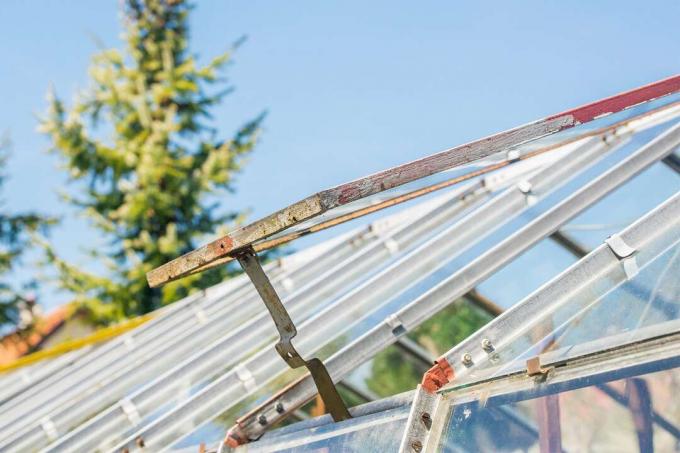
Optimal humidity has a positive effect on plant growth. If the humidity is not right, this can promote the development of diseases or various pests can settle in the greenhouse.
In a nutshell
- optimal humidity between 40% and 75%
- optimal temperature between 20 and 25°C
- Humidity above 80% promotes fungal diseases
- air regularly so that leaf surfaces dry quickly
- Humidity below 20% favors spider mites
Table of contents
- Optimum humidity
- High humidity
- Low humidity
- frequently asked Questions
Optimum humidity
The optimal humidity in the greenhouse is between 40% and 75%. The temperature should be between 20 and 25°C. Outside of the hot summer days, this temperature can also be achieved with the help of a greenhouse heating.

This humidity is optimal for the following plants:
- tomatoes
- eggplants
- paprika
- chili
- honeydew or cantaloupe melon
- cucumbers
- oleander
- Lantana
How high the humidity should be in the optimal range depends on the planted varieties. There are species, especially tomatoes, that are extremely sensitive to higher humidity. This applies in particular to beefsteak tomatoes, where you should aim for the lower limit of 40% humidity in order to avoid diseases
.A notice: As autumn approaches, you should check the humidity in the greenhouse more frequently. If the temperatures drop, evaporation is less, which can automatically result in excessive humidity.
High humidity
If the humidity is too high, various fungal infections are encouraged. Not only can they have a significant negative impact on the harvest by causing the fruit to rot, but the entire plant can die.
In the greenhouse with a humidity level of over 80%, the following diseases can occur:
- gray mold
- Late blight and late blight
- mildew
Especially with tomatoes there is a risk that if the humidity is too high, Late blight and late blight forms. You can prevent this to a limited extent by using plant-strengthening agents such as horsetail or nettle manure, pour.

A notice: Ventilate regularly in summer. As a result, leaves dry faster and fungal infections cannot spread as quickly.
Low humidity
If the humidity is too low, then pests such as spider mites can be favoured. You can recognize pests by the fine webs in the leaf axils and under the leaves. In addition, the damage caused by feeding causes discoloration of the leaves. The advantage is that the Simply let spider mites fightby increasing the humidity. They will disappear on their own within a short period of time.
Combat spider mites:
- Spray leaves with lukewarm water
- remove severely damaged leaves
- Use soapy water
Tip: To prevent spider mites from forming in the first place, you can spray the leaves occasionally. You can use a decoction of horsetail, which not only has a strengthening effect on the roots, but also when you spray it on the leaves.
frequently asked Questions
Humidity is reduced by ventilating regularly over a long period of time. Evaporation is greatest at midday in particular, which means that a lot of moisture is drawn out of the greenhouse. If you mulch in the greenhouse, the moisture in the soil stays close to the roots and does not rise as quickly.
In order to increase the humidity, it is important to distribute water over a large area in the greenhouse. To do this, not only water selectively around the root area, but also moisten the surrounding soil. Also distribute water in the greenhouse by spraying the side walls. It also helps if you put large containers of water in the greenhouse.
Yes, that is possible, but it involves more effort. Cucumbers like it wetter, so it's better Planting cucumbers on the edge of the greenhouse, where more condensation forms on the wall. Plants that appreciate less humidity are planted in the middle of the greenhouse where there is more dry air.


